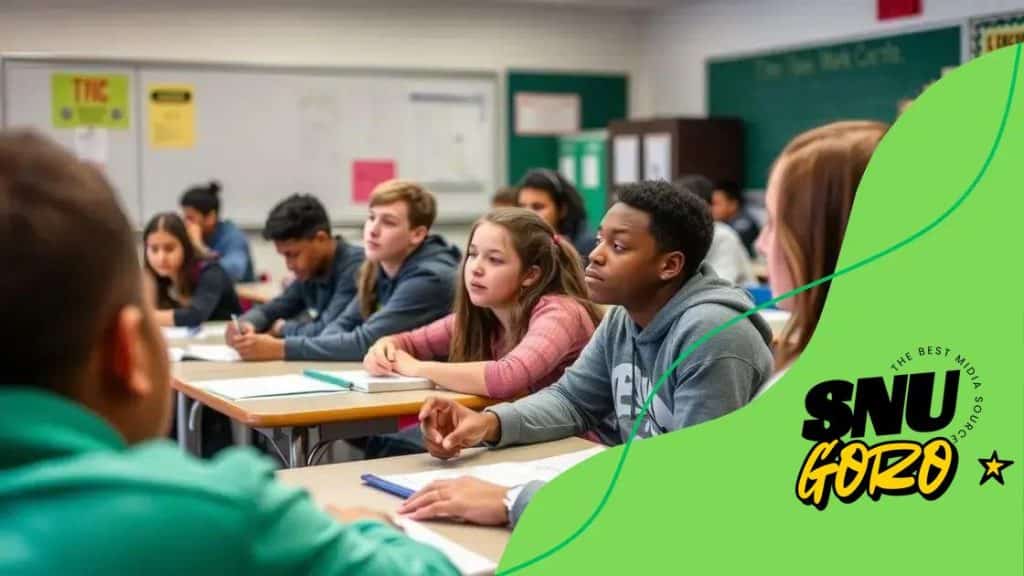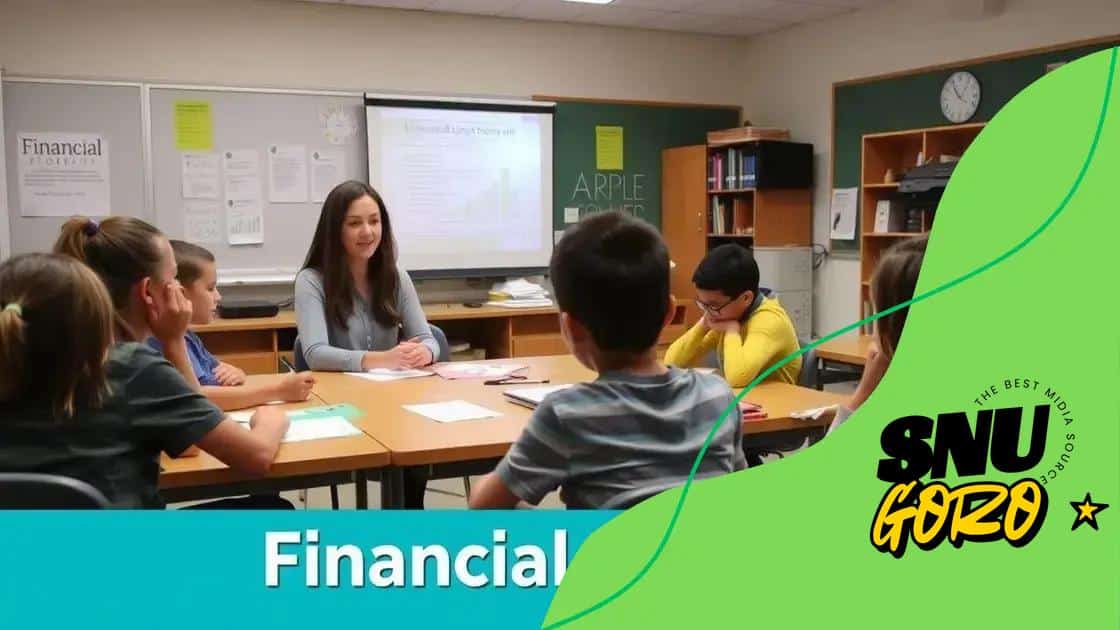Financial literacy programs for high schoolers: why they matter

Financial literacy programs for high schoolers empower teens by teaching essential money management skills, such as budgeting, saving, and investing, which prepare them for future financial independence and responsible decision-making.
Financial literacy programs for high schoolers are essential for equipping teens with vital money management skills. Have you ever thought about how understanding personal finance can shape their future? Let’s dive into this important topic.
Understanding the basics of financial literacy
Understanding the basics of financial literacy is crucial for high schoolers. Financial literacy teaches students how to manage their money, make informed decisions, and prepare for their futures.
Learning about money does not have to be boring! Financial concepts can be made engaging through interactive lessons. When high schoolers grasp the fundamentals, they feel more confident about handling finances.
Key Concepts of Financial Literacy
There are several important ideas to understand when it comes to financial literacy. Here are some of the core concepts:
- Budgeting: Knowing how to create a budget helps track income and expenses.
- Saving: Learning the importance of saving and how to set savings goals can help in the long run.
- Investing: Understanding investing introduces students to growing their money over time.
- Debt Management: Knowing how to handle debt and avoid common pitfalls is crucial.
These concepts lay the foundation of financial literacy. By teaching these skills, programs can enhance students’ understanding of their financial situation.
Moreover, high schoolers are encouraged to ask questions, participate in discussions, and apply their learning. Activities such as mock budgeting or savings challenges make the lessons more relatable and fun. They learn by doing, which sticks with them longer than traditional lectures.
Real-Life Applications
Bringing financial literacy to life through real-world examples helps solidify these concepts. For instance, discussing how to apply for a bank account or how credit works provides practical skills. These discussions help bridge the gap between theory and practice.
Understanding financial literacy is a significant step toward independence. As students learn to manage their finances wisely, they prepare for major life decisions, like college or their first job.
Providing high schoolers with a solid base in financial literacy can make a real difference in their futures. The knowledge gained will not just benefit them personally but can also contribute to a more financially savvy generation overall.
Benefits of financial literacy for teenagers
The benefits of financial literacy for teenagers are immense and can shape their futures. Understanding how to handle money wisely is a skill that will serve them well throughout life.
When teenagers learn about budgeting, saving, and investing, they become more confident in their financial decisions. This knowledge helps them manage their resources effectively.
Critical Advantages of Financial Literacy
Financial literacy provides several key advantages for teens:
- Empowerment: Gaining control over money matters empowers teenagers to make informed choices.
- Future Planning: Understanding finances early helps them plan for education, buying a car, or other significant expenses.
- Debt Awareness: Learning about debt management prevents teenagers from falling into common financial traps.
- Job Readiness: Financial skills make them more attractive to employers who value responsible employees.
These benefits illustrate why financial literacy is important during the teenage years. Moreover, as they acquire these skills, they develop habits that contribute to their overall well-being.
Another significant advantage is the reduced anxiety surrounding money. Teens who feel confident in their financial knowledge are less likely to worry about managing expenses. Instead of fearing the future, they can focus on their goals.
Furthermore, financial literacy promotes responsible spending. Teens learn to differentiate between wants and needs, making them more prudent consumers. This mindfulness can lead to a more sustainable lifestyle as they grow older.
Ultimately, instilling financial literacy in teenagers leads to better outcomes not only for individuals but also for society. Financially educated individuals contribute positively to their communities and the economy.
Engaging methods for teaching finance in schools

Engaging methods for teaching finance in schools can make a significant difference in how students learn about financial literacy. Traditional methods may not capture the interest of students, so innovative approaches are necessary.
One effective method is using real-life scenarios. Creating lessons around actual financial situations helps students relate the concepts to their lives. For example, discussing how to budget for a school event can illustrate the importance of managing money.
Interactive Learning Strategies
Interactive learning strategies can enhance understanding. Activities such as:
- Group Projects: Students can collaborate on creating a business plan or investment strategy.
- Simulation Games: Games that simulate investing or budgeting can create a fun learning environment.
- Workshops: Inviting local financial experts to conduct workshops can provide practical insights.
- Field Trips: Visits to banks or businesses help students see finance in action.
These strategies not only make learning enjoyable but also provide practical experiences that solidify classroom discussions.
Additionally, integrating technology into financial education can be beneficial. Online resources and apps can facilitate interactive budgeting exercises. Many students are tech-savvy and may respond well to digital tools.
Moreover, using storytelling can be a captivating method. Sharing stories about individuals successfully managing their finances or overcoming financial challenges can inspire students. These narratives make the lessons meaningful and relatable.
Finally, encouraging discussions and debates about financial topics fosters critical thinking. Students could discuss the benefits and drawbacks of different saving methods or investment options. This not only helps them understand various perspectives but also develops their communication skills.
Real-life applications of financial literacy skills
Real-life applications of financial literacy skills are crucial for teens as they prepare for adulthood. These skills help students navigate everyday financial situations, making them more confident and capable.
Understanding how to manage their money now will serve them for years to come. For example, knowing how to create a personal budget can help students balance their spending with their income. It is a practical skill that can lead to better financial decision-making.
Smart Spending Practices
Learning about financial literacy also teaches smart spending practices. Teens can benefit from:
- Evaluating Needs vs. Wants: Recognizing the difference between what they need and what they want helps in making informed purchases.
- Comparison Shopping: Understanding how to compare prices and find the best deals can save them money.
- Understanding Sales and Discounts: Knowing how to calculate and evaluate sales can lead to better deals.
- Using Coupons: Learning how to use digital and paper coupons effectively can maximize savings.
These practices not only save money but also help develop a mindset of financial awareness.
Furthermore, real-life applications extend to saving and investing. When high schoolers learn how to save for a purpose, such as a car or college, they gain a sense of achievement. They also learn about the benefits of earning interest and how investing can grow their savings over time.
Exploring bank accounts is another essential aspect. Teens should understand how to open a checking and savings account. This knowledge assists them in managing their finances safely and effectively. They can learn about online banking features that make transactions easier.
Managing Debt Responsibly
Debt management is an important part of financial literacy skills. Students need to grasp the consequences of borrowing money. Understanding credit cards, loans, and interest rates can prepare them for future responsibilities.
By comprehending how to manage debt, teens can avoid financial pitfalls. They learn to pay off balances on time to maintain a good credit score, which will benefit them later in life.
How parents can support financial education
How parents can support financial education is a key aspect in helping teenagers develop important skills. By being involved in their children’s financial learning, parents can reinforce concepts taught in schools and make them more relevant.
One effective way parents can aid in this journey is by discussing money openly. Talking about family budgets, expenditures, and saving goals can help teens see financial concepts in action. By sharing personal experiences, parents make lessons relatable and practical.
Teaching Through Everyday Activities
Parents can also incorporate financial education during everyday activities. Simple actions such as grocery shopping can become valuable teaching moments. Teens can compare prices, use coupons, and understand how to stick to a budget.
- Involve Them in Budgeting: Letting teens help create a family budget teaches them about income and expenses.
- Set Savings Goals Together: Parents can work with their children to set and achieve savings targets for special purchases.
- Discuss Future Expenses: Conversations about upcoming costs, like college or vacations, can reinforce planning skills.
- Encourage Smart Spending: Remind them to think before making purchases, distinguishing between needs and wants.
These strategies encourage teens to grasp the importance of planning and making informed choices.
Additionally, introducing teenagers to concepts like banking and investing can be beneficial. Parents can take their kids to the bank to open an account or discuss how investment accounts work. This hands-on experience gives them confidence in managing their own finances.
Promoting Financial Literacy Resources
Parents can also support financial education by promoting resources. Sharing books, online courses, or apps focused on financial literacy can enrich their learning. Many resources are engaging and are suited for teenagers, making it easier for them to learn independently.
Moreover, encouraging participation in finance-related clubs or competitions fosters a sense of community and shared learning. Being part of such activities not only makes finance fun but also connects students with peers who share similar interests.
Finally, leading by example is a powerful method of support. Parents who practice good financial habits such as saving, budgeting, and investing set a strong example for their children. This modeling reinforces what they learn and motivates them to emulate smart financial behavior.
In conclusion, supporting **financial education** for teenagers is essential for their future. By involving them in conversations about money and including them in family financial activities, parents play a crucial role in building their financial literacy. Teaching students how to make informed financial decisions today prepares them for a successful and responsible financial life tomorrow. From budgeting to understanding investments, the skills they learn now will benefit them for years to come. By being active participants in their financial education, parents can help empower their children to achieve economic independence and stability.
FAQ – Frequently Asked Questions about Financial Literacy Education
Why is financial literacy important for teenagers?
Financial literacy helps teenagers make informed decisions about money, preparing them for real-life financial situations and promoting independence.
How can parents support their children’s financial education?
Parents can engage in open discussions about money, involve kids in budgeting, and provide resources like books and apps to enhance their understanding.
What are some effective teaching methods for financial education?
Interactive learning strategies, such as using real-life examples, simulations, and group activities, help make financial concepts more engaging for students.
What practical skills can teens learn from financial education?
Teens can learn important skills such as budgeting, saving, smart spending, and managing debt, which are essential for their future financial well-being.





